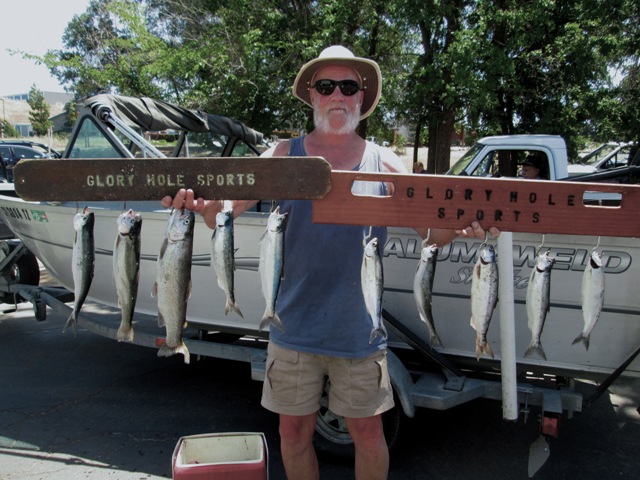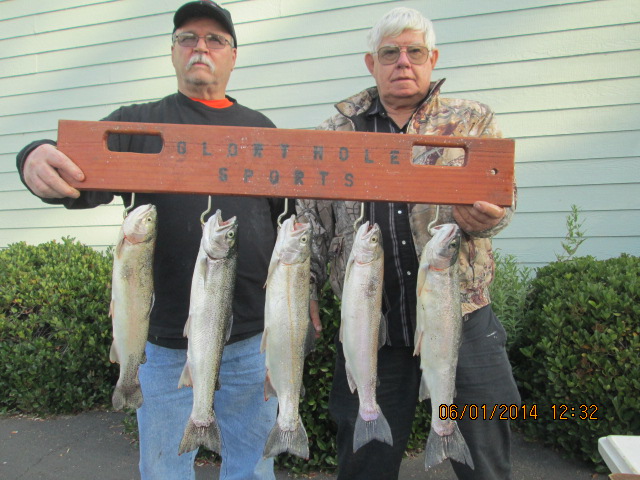Nor Cal Fish Report
New Melones Reservoir Fish Report for 6-16-2014
New Melones Reservoir Fish Report for 6-16-2014
New Melones Reservoir Fish Report
New Melones Reservoir - Angels Camp, CA

by Glory Hole Sports Staff
6-16-2014
(209) 736-4333
Website
Water Conditions: New Melones Lake is currently holding 759,930 acre-feet of water. The lake level dropped four feet this week and is currently at 906 ft. above sea level and 179 ft. from full. The water is stained in most areas of the lake, and fairly clear in others. There are mud lines forming near the shore throughout the day, especially on windy days. The average water temperature is 74-80 degrees and rising daily.
Trout: Fair. Night fishing for trout has been good. Most anglers fishing under submersible lights are catching limits of chunky 2-pound rainbows. Nightcrawlers and Power Bait are working well. The trout will school in deeper/cooler water during the hot summer heat and move into shallow water at night to feed. It is a good idea to anchor in 40-60' of water that is near 100-200' areas. Drop your light 10-20' down and fish your presentations below that. Trolling anglers have been doing better each week and bringing in a handful of nice trout along with their kokanee. The trout are drawn to deeper/cooler water. The main river channel will have the coolest water throughout the summer. Try trolling in 30-50' of water at 2.5-3.0 mph. The shad are schooled up and are a primary food source for trout. Try using baits that best resemble the natural forage. The water is a bit stained so in would be a good idea to include some bright colors in your presentation. Try using bright blades along with natural patterned baits, or natural blades along with brighter baits.
Bank fishing for trout has been very slow. Trout season is open for rivers, and streams, it might be best to try your luck in these areas. If you do choose to target trout from the bank try using chartreuse or rainbow garlic Power Bait. Fly fishing anglers try fishing nymphs under an indicator during the day and switching to mayfly patterns during the evening. Also, try using buggers and streamers in the high country lakes.
Kokanee: Good. The kokanee are biting and most anglers are catching limits. The average size is 11-13" with a few fish measuring 14-16". The fish are schooling in deep water off of Glory Hole Point and near the dam, spillway and Rose Island. A variety of colors are producing limits. Orange has been a favorite for a couple of weeks. Fish will be keying on baits that disperse water and create vibration. Try using different blade style on each setup until you find one that works. Try using spinners, Apex and bladed hoochies. It is also a good idea to modify your dodgers by adding a little bend to them. This modification will give the blade and bait more side-to side swing. Scent is very important when fishing in water with less visibility. Add a Scent Chamber/chain swivel to ensure your setup will have plenty of scent. Garlic, bloody tuna, anise, and kokanee special will work. Don't forget to tip your presentations with dyed and scent shoepeg corn.
Bass: Fair. The bass are done spawning and moving out into deeper water where they will spend the summer. They will move shallow at night and in the morning for a short period of time to feed. Then they will head back to cool water for the hot hours of the day. Try using reaction baits in the cooler hours of the day and switching slower moving baits during the heat. A great presentation that works at all depths is a Carolina Rig. Try using a soft plastic lizard or brush hog and keep contact with the bottom. Another rig that catches fish especially in stained water is a Texas Rig worm with a "brass and glass" weight and bead. With this presentation your can create a Ticking noise by shaking the tip of the rod. This will attract fish from a distance. If you can find balls of shad try dropping a shad patterned worm or a small swim bait down to them. Please practice catch and release. Take photos and carefully release the fish back into to the lake to maintain a healthy fish population for generations to come.
Catfish: Good. Melones cats tend to be fish-eaters rather than bottom foragers, so use frozen shad, mackerel, chicken liver, or anchovies for best success. Larger cats will also feed on natural bait like crawlers. To target large cats try using a big ball of crawlers.
Crappie: Slow. Try a live minnow in tandem with a mini jig. The color of the jig will draw fish to it, and the live minnow triggers the bite. With the water warming up the fish will suspend in the middle of main lake creek channels. Try to find trees and flooded timber in 25-40 feet of water.
Trout: Fair. Night fishing for trout has been good. Most anglers fishing under submersible lights are catching limits of chunky 2-pound rainbows. Nightcrawlers and Power Bait are working well. The trout will school in deeper/cooler water during the hot summer heat and move into shallow water at night to feed. It is a good idea to anchor in 40-60' of water that is near 100-200' areas. Drop your light 10-20' down and fish your presentations below that. Trolling anglers have been doing better each week and bringing in a handful of nice trout along with their kokanee. The trout are drawn to deeper/cooler water. The main river channel will have the coolest water throughout the summer. Try trolling in 30-50' of water at 2.5-3.0 mph. The shad are schooled up and are a primary food source for trout. Try using baits that best resemble the natural forage. The water is a bit stained so in would be a good idea to include some bright colors in your presentation. Try using bright blades along with natural patterned baits, or natural blades along with brighter baits.
Bank fishing for trout has been very slow. Trout season is open for rivers, and streams, it might be best to try your luck in these areas. If you do choose to target trout from the bank try using chartreuse or rainbow garlic Power Bait. Fly fishing anglers try fishing nymphs under an indicator during the day and switching to mayfly patterns during the evening. Also, try using buggers and streamers in the high country lakes.
Kokanee: Good. The kokanee are biting and most anglers are catching limits. The average size is 11-13" with a few fish measuring 14-16". The fish are schooling in deep water off of Glory Hole Point and near the dam, spillway and Rose Island. A variety of colors are producing limits. Orange has been a favorite for a couple of weeks. Fish will be keying on baits that disperse water and create vibration. Try using different blade style on each setup until you find one that works. Try using spinners, Apex and bladed hoochies. It is also a good idea to modify your dodgers by adding a little bend to them. This modification will give the blade and bait more side-to side swing. Scent is very important when fishing in water with less visibility. Add a Scent Chamber/chain swivel to ensure your setup will have plenty of scent. Garlic, bloody tuna, anise, and kokanee special will work. Don't forget to tip your presentations with dyed and scent shoepeg corn.
Bass: Fair. The bass are done spawning and moving out into deeper water where they will spend the summer. They will move shallow at night and in the morning for a short period of time to feed. Then they will head back to cool water for the hot hours of the day. Try using reaction baits in the cooler hours of the day and switching slower moving baits during the heat. A great presentation that works at all depths is a Carolina Rig. Try using a soft plastic lizard or brush hog and keep contact with the bottom. Another rig that catches fish especially in stained water is a Texas Rig worm with a "brass and glass" weight and bead. With this presentation your can create a Ticking noise by shaking the tip of the rod. This will attract fish from a distance. If you can find balls of shad try dropping a shad patterned worm or a small swim bait down to them. Please practice catch and release. Take photos and carefully release the fish back into to the lake to maintain a healthy fish population for generations to come.
Catfish: Good. Melones cats tend to be fish-eaters rather than bottom foragers, so use frozen shad, mackerel, chicken liver, or anchovies for best success. Larger cats will also feed on natural bait like crawlers. To target large cats try using a big ball of crawlers.
Crappie: Slow. Try a live minnow in tandem with a mini jig. The color of the jig will draw fish to it, and the live minnow triggers the bite. With the water warming up the fish will suspend in the middle of main lake creek channels. Try to find trees and flooded timber in 25-40 feet of water.
< Previous Report Next Report >
< Previous Report Next Report >
More Reports
New Melones Reservoir Fish Report
New Melones Reservoir
6-9-2014
Water Conditions: New Melones Lake is currently holding 780,151 acre-feet of water. The lake level dropped...... Read More
New Melones Reservoir Fish Report
New Melones Reservoir
6-2-2014
Water Conditions: New Melones Lake is currently holding 798,080 acre-feet of water. The lake level dropped three feet...... Read More

www.NorCalFishReports.com © 2024. All Rights Reserved.
Website Hosting and Design provided by TECK.net
Website Hosting and Design provided by TECK.net